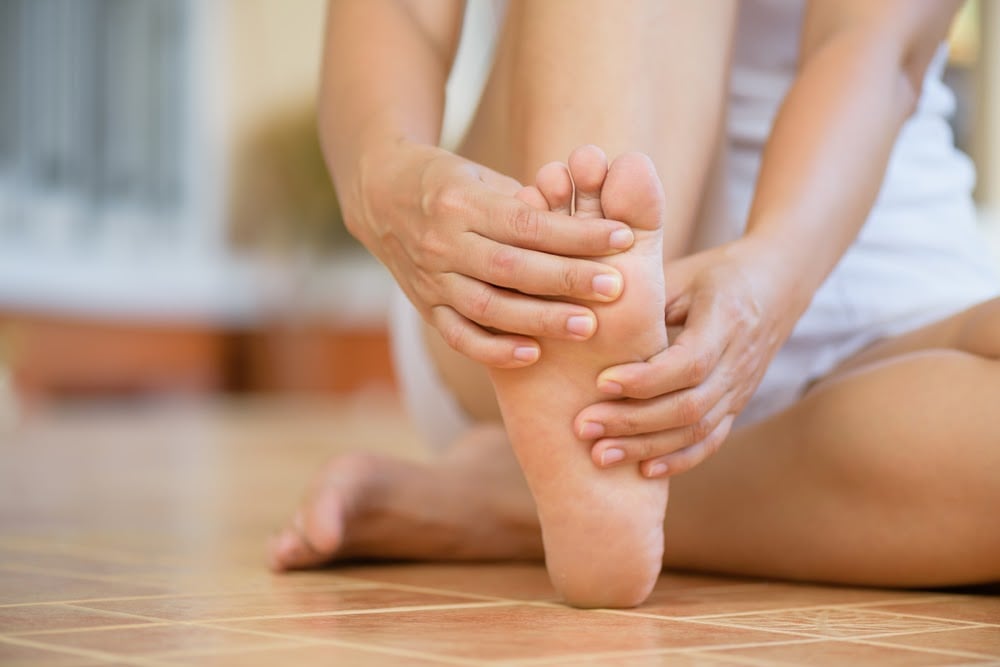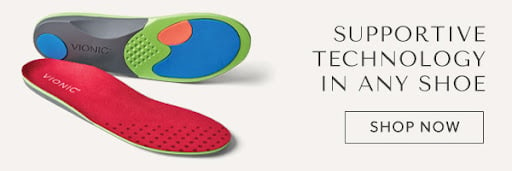
Prolonged standing can not only cause tired aching feet but also other foot conditions, even chronic foot pain. If your feet tend to ache and throb when you return home from a long day, you’re not alone. Experiencing sore feet after work is incredibly common—so common, in fact, that many people accept it as a fact of life. But it doesn’t have to be that way. So, how do you soothe sore feet from standing all day?
Here at Vionic, we’re passionate about foot health and are dedicated to helping individuals feel good in their slip-resistant shoes for work , day after day, no matter how many hours they spend on their feet. While there are ways to prevent foot fatigue and pain, experiencing a foot problem or two is inevitable. So, what should you do if your feet hurt after work? Find self-care practices, therapies, and practical pointers below.
Tips to Soothe Sore Feet After Work
Soak
Trying to figure out how to soothe aching feet after work? One of the best ways to find relief is to soak your feet.¹ Whether you draw a full bath or just a foot bath, dipping into some warm water for as little as 20 minutes can make a big difference if you’re suffering from foot fatigue. To take it up a notch, you might consider adding Epsom salt (magnesium sulfate) to your foot soak, which can help reduce swollen feet and alleviate soreness.
Ice
Icing your feet can also be a home remedy to relieve inflammation, swelling, and overall soreness. If you have pain in your ankle or joints from gout, bursitis, arthritis, or a past injury, this option can be especially beneficial.
You can immerse your feet in ice water (or just very cold water) for a few minutes or apply a cold compress. A bag of frozen peas is an excellent standby, but a plastic bag of ice or a ready-made cold pack works too. In any case, we recommend wrapping the cold compress in a cloth napkin or thin towel before applying it to your skin. About 15 minutes a day should be enough to soothe and relieve sore feet after work.
Stretch
When your feet hurt after work, stretching can help. You can leverage various techniques and foot health exercises to target specific areas, such as your toes or arches, or engage your entire foot. Stretching your ankles, calves, legs, and hips can be beneficial too for sore muscles.
To relieve sore feet after a long day, try:
- Flexing your toes, then pointing them, then holding them in a curl for five to ten seconds
- Extending your legs outward while sitting in a chair and moving your ankles in circular motions
- Extending your legs outward while seated and alternating between pointing and flexing your toes
- Shifting back and forth from your toes to your heels while standing up straight
You can repeat each of these foot exercises and stretching moves ten or so times. Doing this every day might offer some relief from foot pain and discomfort while promoting flexibility and preventing cramping.²
Strengthen
- Keeping your feet and legs flexible and strong is crucial to preventing foot or heel pain. In addition to regular stretching, you may want to implement various exercises into your routine to help with sore muscles and severe pain. Since a sedentary lifestyle can make things worse, making a point to move your body is a great place to start. Daily walks can help keep your lower extremities healthy and limber.
Targeted strengthening exercises are a good option, too, as resistance training can make your feet stronger and prevent muscle soreness.³ There are lots of moves you can do using simple household items or even just your own body weight.
To prevent sore feet after work, try:
- Placing a towel flat on the floor in front of you, then setting your foot on it while seated and slowly dragging it toward your body
- Spreading your toes as far apart as you can without straining them and hold for five to ten seconds
- Placing one or more marbles on the floor and trying to pick them up with your toes
- Standing on the edge of a step or flat on the floor, then rising up to your tiptoes while flexing your calves, then slowly returning to a neutral position
Each of these moves can be repeated ten or more times. For best results, try to do a series of exercises every day along with a stretching routine. Even a few minutes can make a substantial difference.
Massage
A foot massage can also be very helpful if your feet hurt after work. If a loved one is willing and available to rub your feet, great! If not, you’ve got options. With the right techniques, you can massage your own feet to increase blood flow and circulation, relieve soreness in your foot muscles, and reduce cramping.
Start by sitting on a couch or comfy chair. Place one of your ankles over the opposite knee so that you can easily reach your foot. Knead the arches of your feet while flexing your toes and ankles. Try pressing your thumbs into the bottom of your foot or any sore spots, and hold it there for a few seconds. You can also place your fingers between your toes to pull them apart and gently move them back and forth.
Another option is to use foot rollers or a tennis ball to massage the arches of your achy feet. Electric foot massager tools have come a long way in recent years as well. It might be worth reading through some reviews and trying one of the top-rated options.
Over-the-Counter Pain Relief
Over-the-counter NSAIDs (nonsteroidal anti-inflammatory drugs) and pain relievers like ibuprofen and acetaminophen can be very helpful in reducing swelling, muscle soreness, and inflammation. Taking Advil or Tylenol regularly might provide substantial foot pain relief, but make sure to check with your healthcare provider about ongoing use.
Get a Pair of Orthotic Shoe Inserts
Even if you find a comfortable shoe, it may not perform well after long and extensive usage, resulting in an aching heel bone or other foot problems. Have you considered orthotic inserts? Shoes are often a culprit for an achy or sore foot, but the right insoles can make a world of difference. If you wear a wide variety of different types of dress shoes, heels, loafers, casual sneakers, ankle boots, or flats, orthotics can provide you with the arch support, stability, and alignment you need.
Before we recommend some orthotic footwear, you might be wondering, “What are orthotics?” It is actually a branch of health and medicine that deals with designing footwear for people with foot and back problems. This is ideal for people experiencing some of the most common foot injuries.
Vionic carries several supportive insoles for men and women. You can place them in any type of shoe and wear them for any activity. Whether you spend most of your workday standing, sitting at a desk, or walking around, our orthotics can offer the relief and soothing comfort you crave while reducing post-work aches and pains.
Invest in Proper Footwear
In the same vein, investing in proper footwear is often the key to preventing aching feet after work. Wearing shoes that are the wrong size or that lack support can be detrimental to your short- and long-term foot health. It may also lead to problems like plantar fasciitis, Morton’s neuroma, a heel spur, an ingrown toenail, bunions, and other painful foot problems. When people switch to supportive footwear in the right size, their aches and pains often subside. Before you make any purchases, be sure you understand how to measure your shoe size to ensure you have properly fitting shoes.
Know The Right Size
According to a 2018 study, as many as 72% of people wear shoes that don’t accommodate the length or width of their feet.⁴ Feet can get wider and longer in adulthood for various reasons. Still, it’s understandable that many believe their teenage shoe size is their forever size.
While you might think you know your size, we suggest measuring your feet to be sure. You can get your measurements by standing on a piece of paper, drawing an outline around your feet, and measuring a straight line between the widest and longest portions.
Supportive, Comfortable Shoes
As for your shoes, your best bet is to get a pair (or multiple pairs) with built-in arch support to avoid any unwanted foot discomfort. You should look for options with deep heel cups, generous toe boxes, flexible midsoles, supportive contouring, stability, and soft cushioning.
If you work in an office that calls for a business-casual or semi-formal dress code, you might think your only option is to wear stiff dress shoes, flats, or heels that lack support. Or maybe you work in a hospital or restaurant and haven’t been able to find non-slip shoes that don’t hurt your feet. We have tips for how to tell if shoes are slip resistant so you can find the perfect shoe. Believe it or not, you can find plenty of stylish, supportive, comfortable, slip-resistant options, like the fashion-forward orthotic footwear from Vionic.
Be Kind to Your Feet with Vionic
Discover the perfect blend of style, comfort, and functionality with Vionic’s collection of footwear. From slip-resistant shoes and sneakers to office-ready flats, heels, loafers, and dress shoes, our range offers something for everyone.
Each pair is thoughtfully designed by podiatrists to not only align with the latest fashion trends but also provide exceptional comfort. With Vio Motion technology in every shoe, you can trust that you’ll enjoy maximum arch support, cushioning, and stability.
Explore our collections today and step into comfort like never before! Check out our APMA-accepted shoes for the ultimate foot care and comfort.
Sources:
1. Natalie Silver. “10 Home Remedies to Relieve Sore Feet”. Healthline. Nov 21, 2018, https://www.healthline.com/health/sore-feet-remedies
2. Amanda Barrell. “Remedies for sore feet”. Medical News Today. Apr 9, 2020, https://www.medicalnewstoday.com/articles/sore-feet-remedies
3. Catherine Moyer. “Self-Care Tips to Soothe Aching Feet at Home”. Verywell Health. Sept 25, 2020, https://www.verywellhealth.com/tips-to-fix-aching-feet-1337689
4. Buldt, Andrew K, and Hylton B Menz. “Incorrectly fitted footwear, foot pain and foot disorders: a systematic search and narrative review of the literature.” Journal of foot and ankle research vol. 11 43. 28 Jul. 2018, doi:10.1186/s13047-018-0284-z


Robbin
It was really helpful. Thanks for sharing these tips. Keep posting!!